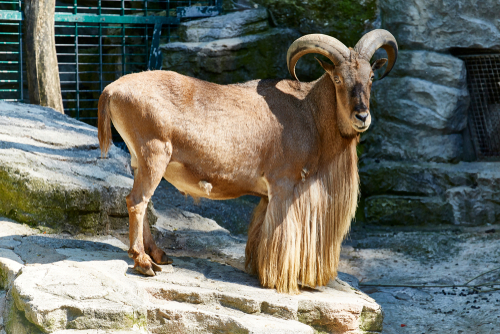
Surprisingly, the Aoudad, or the Barbary sheep, is the only native sheep in Africa. This is a very interesting species, and today’s blog post will discuss all about the Aoudad.
In the early 1900s, these one-of-a-kind mammals were transported to the United States for exhibitionary purposes in zoos and parks. Due to their apparent success at creating little aoudads, there was quite a surplus in the population. This new abundance was used to establish populations on a variety of appropriate lands. In the current day, there are free-ranging populations in California, Texas, and New Mexico. Juxtaposing the growing U.S. population, in Africa, the number of Aoudads are abating due to a loss of ideal habitat. Not only are the hide, hair, and sinews a staple in the economy, but the Saharan people rely on the Aoudad as a source of food.
Standing approximately 40 inches tall and weighing anywhere between 100 and 300 pounds, the Aoudad is characterized by a light, reddish-brown, bristly outer coat that provides camouflage to their dusty desert surroundings. Typically, the underbelly is lighter in color while the back tends to be slightly darker. One of the keynote features of the Aoudad is the long, soft fringe of hair that treads from the throat to the forequarters. Another distinguishable feature are the horns that curve outward, back and then inward toward the neck. Just like human fingernails, their horns are made of keratin. Not surprisingly, both the fringe and horns are more conspicuous in the male. Also considered remarkable and quite interesting are their horizontal pupils surrounded by yellow irises.
Generally, Aoudads reside in dry, rocky, or mountainous terrain where they can dwell in small, familial groups. They are native to northern Africa, but populations have been introduced to Spain, the United States, and other parts of Africa. Naturally, these beasts are adroit climbers and jumpers that follow a diurnal pattern of life, but will often seek a spot of shade during the blazing heat of the day. Due to their environment, they tend to be grazers that will feast on multifarious sources of grasses, shrubs, and other flora. Fortunately for them, they are able to survive several days without water, as they obtain the majority of it from their diet as well as dew. Longevity for Aoudads tends to be about 15 years, but can extend up to 20 years.
From September to November, you’ll find Aoudads to be in their peak breeding season. Following a gestation period of about 160 days, one to three kids are born. Twins are not uncommon in Aoudads, and if food sources are plentiful, the mother may have three. It’s possible for a female Aoudad to have two pregnancies in one year. At about three to four months old, the kids are weaned and around 18 months, they achieve sexual maturity. Almost immediately after being born, little Aoudads are adept at handling mountainous, rocky terrain.
Socially, there is normally one male for several females. Though the males will compete for dominance in breeding, multiple males in one group can get along well.
Here at Nine Bar Ranch, we provide an opportunity to hunt the free-range Aoudads that you’ve always imagined. We offer exceptional deals on hunting packages. Tracking down an Aoudad is important, but so is the experience. Don’t fret; we’ve got it all covered. Contact us for questions or if you’re ready to book your next outstanding hunting adventure.
